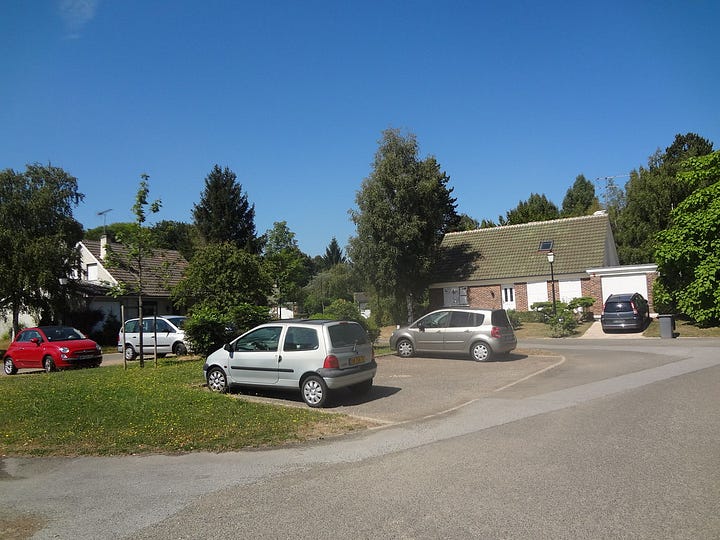

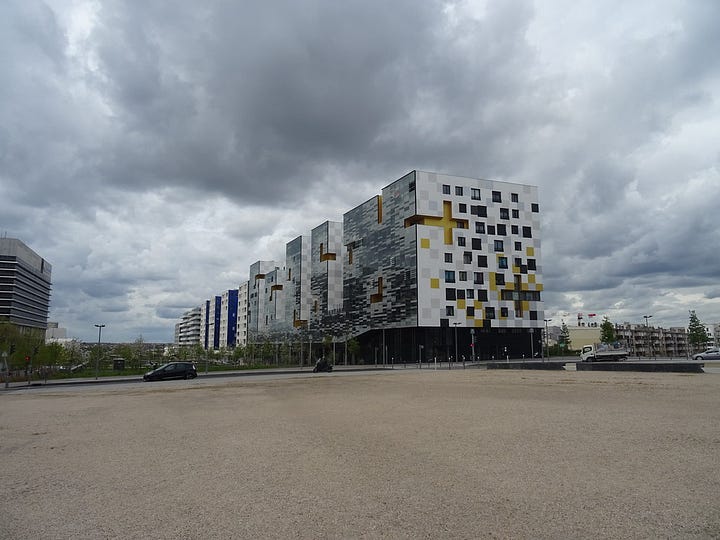
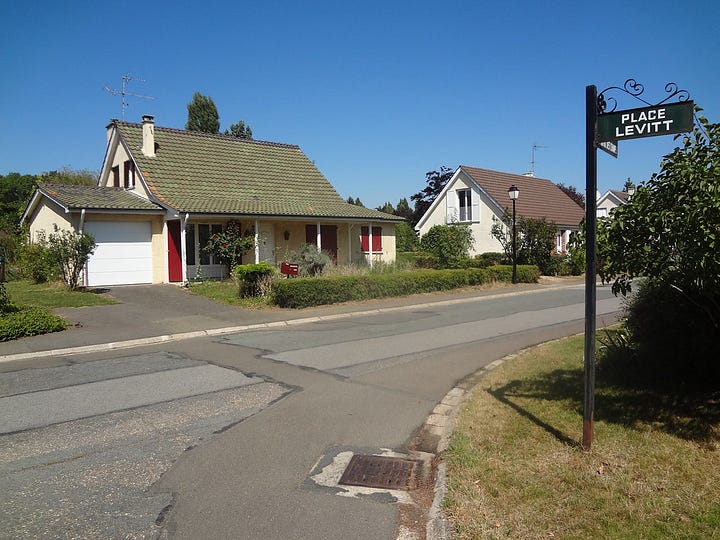
About This Episode
Today’s guest, Dr. Magda Maaoui, is an Assistant Professor of Urban Planning at the Harvard Graduate School of Design, and a Researcher affiliated with the Joint Center for Housing Studies. Prior to that, she was an Urban Planner and Research Associate at the Atelier Parisien d’Urbanisme (APUR), which is a key regional planning organization in greater Paris, where Magda grew up. I’ve had the pleasure of knowing Magda for more than a decade, ever since she was an intern at our own Bay Area regional think tank, SPUR. Magda is one of the most thoughtful, intelligent and passionate housers I know, and someone uniquely positioned to help American housers understand all that team France has to offer us. Join us for a nerdy chat about French housing, about why France and the US are more alike than we think, and about what we can learn from French success. I hope you enjoy this conversation, and thanks as always to all of your who support the podcast and substack. If you are not already a subscriber, consider joining? Allez les Bleus!
This Episode’s Guest
Magda Maaoui is Assistant Professor of urban planning at the Harvard Graduate School of Design, and a Researcher affiliated with the Joint Center for Housing Studies. Prior to that, she was an Urban Planner and Research Associate at the Atelier Parisien d'Urbanisme (APUR),1 acted as an external expert consultant for the OECD, and was an Adjunct Professor at the University of Paris Cité.
She explores the housing production cycle from start to finish: as the consequence of regulation and policy, an act of design and construction, and a catalyst for neighborhood health and environmental outcomes. In her research, she contrasts this long-exposure housing study between neighborhoods of the Global North and South, comparing coalitions and results. In her work as a planner, she puts this scholarship into practice, engaging community groups and political leaders to respond to the global housing crisis, one roof at a time.
With this, she wants to empower the next generation of planners - scholars and practitioners alike. In her classes, they grasp how some debates and lines of thought that drive urban planning are reiterations of the past and yet with little ode to it, and they imagine new modes of practice across all scales of the built environment.
Dr Maaoui tip-toes that elusive line of academia meets practice, with research that solves real planning problems, and boots on the ground that inform better planning scholarship. She evaluates strategies for the preservation and creation of affordable housing including, adaptive reuse, infill densification, inclusionary zoning, fair-share mandates and rent stabilization. She therefore intends to produce policy-relevant, actionable findings for legislators, planners, and advocacy organizations eager to rethink land use systems. She holds a PhD in Urban Planning from Columbia University GSAPP. Her dissertation, successfully defended in 2021, looked at how politics and power relations have shaped inclusionary zoning outcomes in French and American historically disinvested neighborhoods. This comparative political economy was based on sociological and econometric research which she carried during four years of fieldwork shadowing public sector agents in charge of housing provision in New York and Paris. She spent these years investigating the construction of two mixed-income eco-district housing projects, the Fort d’Aubervilliers in the Seine-Saint-Denis department, and Sendero Verde in East Harlem.
Normalienne agrégée with an academic and professional experience acquired in Europe (France, Denmark), Africa (Algeria, Morocco, Senegal) and the Americas (United States, Canada, Costa Rica), projects she has worked on range from sustainable policy to housing and education, community planning and neighborhood revitalization. She received a Bachelor in Planning and Geography from the Université Lyon II Lumière, and a Masters in Planning and Geography from the École Normale Supérieure de Lyon, with high honors. She held a Visiting scholar position at UC Berkeley during her Masters training, and was also a Fulbright Fellow. Her planning thesis (Magna Cum Laude), titled “East Palo Alto: the Gentrification of a Suburban Ghetto? Urban Representations and Gentrification Pressure in the Silicon Valley” investigated longitudinal gentrification-induced displacement threats impacting historically disinvested neighborhoods neighboring Silicon Valley tech campuses.
Her research has been featured in popular news sources including Le Monde, Architectural Review, Ouest France, Bondy Blog, La Gazette des Communes, as well as NPR, the France Inter and France Culture public radios. It has also been used in campaigns for good governance and affordable housing provision reform in France and in the United States. Most importantly, her competencies provide her with a fascination for urban politics and community development - a fascination which also drives her advocacy work and nonprofit engagements.
She maintains an active stream of collaborative research. She is a member of the APA, ACSPand Urban Affairs Association networksand a reviewer for the Revue Urbanités. She has written or co-written peer-reviewed articles for the Journal of Urban Affairs, Journal of Planning Education and Research, Housing Studies, Urban Studies and the Berkeley Planning Journal. She has contributed to the books Habiter l'Indépendance (2022), Zoning: a Guide for 21st-Century Planning(2020), Pour en finir avec le petit Paris (2024) and the critical comparative planning encyclopedia Nos Lieux Communs (2024).
Interview Transcript
Alex Schafran: Magda Maaoui, welcome to Housing After Dark. It’s a real pleasure to have you.
Magda Maaoui: Thank you so much, Alex. I absolutely love the podcast and the newsletter. It’s not because we know each other, it’s genuinely one of the most thoughtful put together accounts on what’s happening right now in California, but also the roots of it all. Appreciate being a guest on this podcast.
Alex Schafran: Well, it’s wonderful to have you. Your notes of encouragement over the years have been really meaningful. I don’t get that many actually, even though I know people like what we put out on the podcast and the writing—it is really meaningful. And it’s exciting once again to have a listener and a reader as a guest on the podcast, I feel like that’s one of the things I’m very much trying to do.
As one of those listeners/readers, you know how we do things here. We like to start with people’s stories of how they became a houser. And your story is a little bit entertwined with my story, which I’m excited to talk about, so tell us a bit about how it began.
Magda Maaoui: I want to situate it back in my city, the city that I left to move to Massachusetts where I am based now, which is Paris. It’s really the city that defined all of my career so far and shaped how I think about urbanism, housing, social justice, health, and amenity access in general. I began my training not in housing—I feel it’s a common theme for guests on your podcast, we were not necessarily born into that. I started my training first to become a public civil servant. Back in France, you can start that very early. I was in my teenage years actually and already picking a path for myself that would allow me to study in schools,go to places, and access opportunities that I would’ve not had access to if I had not chosen the path of public civil service. It’s partly why I chose that path, but I was also a really big believer in the public sector, and that is still true today, especially in the field of housing.
Through the school that I went to, the École Normale Supérieure, which is a Paris-based school with an antenna in Lyon, I got access to parts of the world that I would have never seen otherwise. An example of how I really fell into the housing space: in the early years of my training, I was picked to do an internship in an economics lab in Central America. It was not focused on housing at first, but looking at migrant networks circulating through Central America, and whether they had equal access to the labor market and housing opportunities in Costa Rica, Nicaragua and Panama.
That really was the turning point that led me to realize that a lot of what I was learning in North and Central America was really an eye opener for my own path. I’m a French-Algerian immigrant, a third-generation French. Everything that defines how I live and how my family has lived is through the migratory lens, and I realize that going all the way to another continent allowed me to better understand the structures of my own path and how I thought about my life and my career. That’s when I really started to work on comparative housing. That later led me to practice both in France and in California—which is the starting point of where we met and started connecting—and I haven’t stopped since then thinking about housing in three ways. I typically define it as three pillars, sort of my French holy trinity approach to life. The first pillar is how you think about housing as the manifestation of regulations and policies, be they good or bad. The second pillar is more about the physical, material, side of housing—how do we build it, why is it always political and conflictual, as a construction site that brings together people who fight about the definition and value of housing. And thirdly, housing as way more than a simple housing unit, and as the beginning of neighborhood outcomes, specifically health outcomes. I am specifically focused on health and environmental outcomes connected to housing.
Alex Schafran: I’m excited to get deeper into a bunch of those things. All of my episodes are wonkish, but this one is going to get even wonkier today. We’re going to get into a lot of the very specific interventions that the French system has in housing that I think are things we both agree that we can learn from. Magda’s got her list of four, and I have a few more that I want to add on there.
Before we get there, I want to continue a bit with your story. I think it’s important for guests to understand that you have a particular relationship to this country, not just that you are a professor at Harvard now, but going back to your time at SPUR and Columbia. You spent a lot of time learning in America. There aren’t very many people that I know that understand the two systems comparatively well.
Let’s go back. You came to the Bay Area for the first time in 2012?
Magda Maaoui: Something like that.
Alex Schafran: You then worked with Egon Terplan, a friend of mine, and friend of the show, and friend of everyone, during the Gabe Metcalf administration at SPUR. So, tell us a little story about how you came there and how you ended up at Columbia, and now back at Harvard.
Magda Maaoui: So, after that episode that I talked about in Central America, I was given again through my civil servantship, the opportunity to be a visiting scholar first at Berkeley. I spent a year there and was trained with fantastic people who were injecting a lot of incredible lenses and dimensions into how we think about urbanism and housing, which completed the more technical side of things that I was learning back in Europe. After that, I just wanted to get into the housing arena, after that year during which I had discovered different kinds of coalitions of people working to advance zoning reform, planning reform, and community organizing around housing. All kinds of stakeholders were making the SF Bay Area and pushing the envelope, and I wanted to be a part of that.
And Egon, who took a chance on me, facilitated that defining moment, in the sense that it was right around the time that SPUR was creating its SPUR office in Oakland on the other side of the Bay.
Alex Schafran: Which sadly is no more.
Magda Maaoui: Yes, exactly. The whole plan was that I would be part of a larger team of people working on writing this report analyzing all kinds of opportunities and thoughtful ways in which there were projects that we could advance in Oakland, as well as on the Regional Planning front, which were all never implemented, and it took 10 years to move things forward, I believe. That's sad, but to me, it was a real defining moment of understanding ways in which planning was done so differently from France.
There was a lot of involvement from stakeholders that I was not used to seeing. People pushing interesting and really progressive agendas from the margins, which I didn't see in France because there, it was super top down, and Paris again, which is the city where I'm from, had more of a hyper-procedural way of doing things, planning wise and housing wise. What's striking is, I was learning the stuff of moving things around and using the power of coalitions to pass reforms in the Bay Area, and then brought that back home with me the year after that. I got involved through work, and my training, in a moment where Paris was completely redefining the way it did planning, leading up to when Anne Hidalgo was becoming Mayor in 2014. 2016 was also the moment when the Grand Paris metro region officially became an entity.
There were all kinds of agencies and institutions that were being created or reinforced. And, more importantly, processes were being rethought, and so it was almost like a convergence of Paris and San Francisco, just generally speaking the good stuff of the US and the good stuff of France, towards which France could aspire that were sort of meeting in the middle.
I can talk about the negative stuff, but here I’m thinking about breaking the classic, very traditional, very heavy protocols, connecting more to the private sector in a way that was useful and utilitarian. All that stuff was happening around 2014 and in subsequent years. I learned a lot about San Francisco during that time, but it also helped me work better in France, if that makes sense.
Alex Schafran: To a certain extent, as an American, it's kind of hard for me to imagine, what about housing and land use policy that you could ever learn from this country to apply in a place like Paris. But I do actually, as somebody who has lived in France for almost a decade, and is very connected to your home country in all kinds of ways. It is an important part of that conversation. So maybe one of the things that we agree on is not just that both countries can learn from each other in terms of their housing or land use systems, but that we're not that different to begin with.
That is something that came up in our earlier conversations, and I'm kind of curious, how and why you see this case. What are the things about the two countries that you think kind of hold us together?
Magda Maaoui: I want to start by saying that we are, on both sides of the Atlantic, faced with challenges. Clearly, the magnitude of what's happening right now in the US is in no way comparable to the challenges that France is facing. But we are in a situation where, over the past few months in France, we couldn't agree on anything. We were faced with a looming threat of austerity politics. We have a mounting national debt. It was really hard to reach a consensus to vote on budgets. I see it with former colleagues of mine, and I discussed that with people at the planning agency of Paris, at the OECD, at the Ministry of Housing, they're all saying that it has huge repercussions on anything they can do, or draw as a roadmap for the coming year. It's really stalling a lot of stuff, and putting us in a political crisis. Clearly, again, no comparable magnitude with what's happening here [in the US]. But what I want to insist upon, and give us a premise, is we're not in a situation where we're talking about France, where everything's jolly and beautiful and easy, while America is faced with the biggest challenges of its contemporary history, if not more.
I want to underscore that the interesting, powerful, strong stuff that we know how to do well in France stem from moments of crisis. If we go back just recently to the economic crisis that was happening in the 1970s, a lot of austerity politics around then, and a rethinking of the place of the public sector, also led to a huge transformation in how we thought about homeownership. That's one example.
The second example was the 1990s, when France was all of a sudden struggling with its relationship to its immigrant population, its margins, and its suburbs that were typically lower-income, and more disinvested than other parts of cities and urban cores. Around that time, we enter the 1990s, a huge decade of reform, in the midst of the biggest crisis ever from a socioeconomic standpoint. That led to the SRU law, which is the fair share law that everybody loves us for, and which is a core part of my research. And then you look at 2010, the decade of the crash, with a full restructuring of the housing market. What do we do? We borrow from a technique that allows us to basically institutionalize public private partnerships, but “à la française”, in a way where we really lock what it means for the private sector to be involved in housing provision. We allow them to give us the capital. We allow them to play a big role during the early phases of the chain of production, but then they're not involved in ownership, maintenance, etc.
And to me, again, we always love to sort of evoke these examples as, “Oh, best practices.” But we forget that these stem from moments of huge uncertainty, crisis, and so that's something I want to underscore, to give a little bit of a glimpse of hope in this very tough moment where people could say, “Give me a break while you're talking about best practices. Stop looking at Europe with starry eyes. This is not what I want to hear right now.” Instead, what I'm saying is, “No, actually, this is the moment when we have to look outside the US and see when people have been faced with huge crises, and how they’ve reacted in a resilient way to that.”
Alex Schafran: I love that that was your answer, it wasn't the answer that I thought you were going to give me. I didn't think that you were going to point to the role that crises plays and how we react to them. I think it's super important. I used to, when I taught in Paris, take my students at the end of every class to Nanterre, to do a tour of the origin story of the HLM, the public housing system in Paris, and how it emerged from a very specific crisis. A very specific, terrible winter, in which migrants living in tent camps were dying because of the cold, and that was the crisis that created this reaction in the post war era to build the HLM (Habitations à Loyer Modéré) system. And the irony is, part of Nanterre that was the center of that now has itself been redeveloped right on the edge of La Défense, and is now the site of many new redevelopments, both housing and non housing.
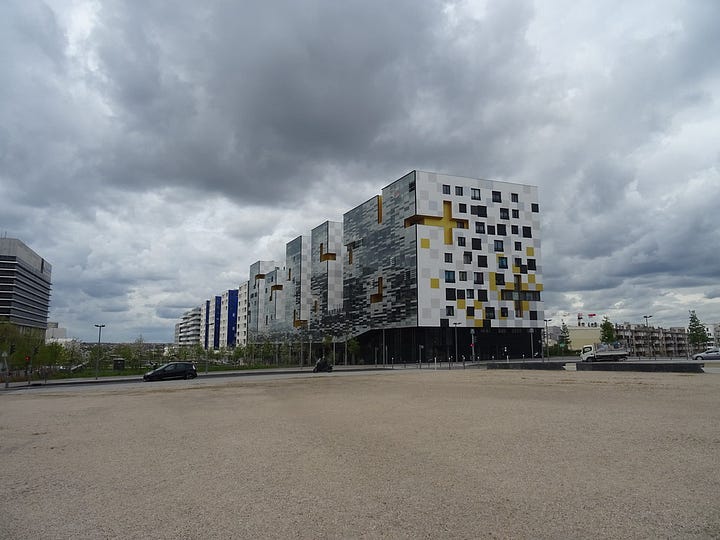

We had a similar reaction in the creation of the public housing system here, during a slightly earlier crisis in the 1930s, with Catherine Bauer. In many ways, we were, at that point, trying to learn from innovations that were happening in Europe at that same time. But it was also a kind of crisis-based response.
I think that even at the most basic level, a lot of American housers misunderstand Europe. here's a lot of homeowners in a lot of different parts of Europe, including in France, many of whom are living in single-family homes. In France, you call them the pavillons. I think the artwork for this episode will include some of my pictures of Levittown, France, outside of Saint-Quentin-en-Yvelines. And you know, I was thinking about it recently because I was at The Broad in Los Angeles, an amazing museum, if you've never been to the collection of Eli Broad, of Kaufman and Broad. And who is it that brought American-style suburbia to France in the 1970s? It was Kaufman and Broad. And you still see Kaufman and Broad in a lot of different places in France.
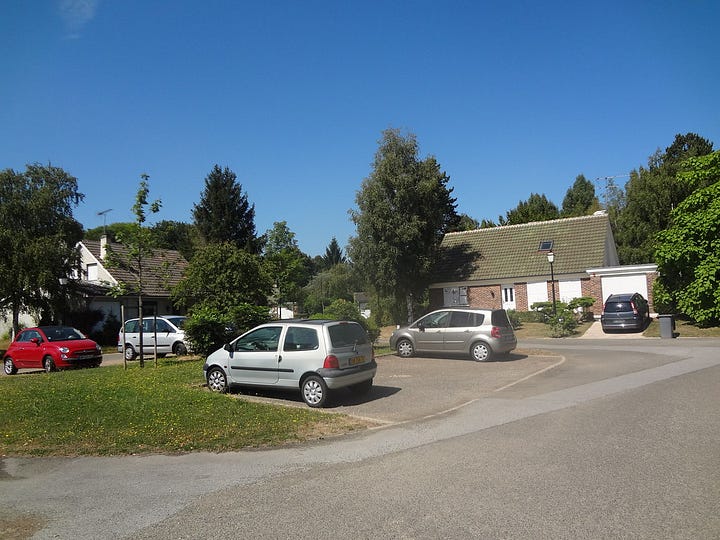
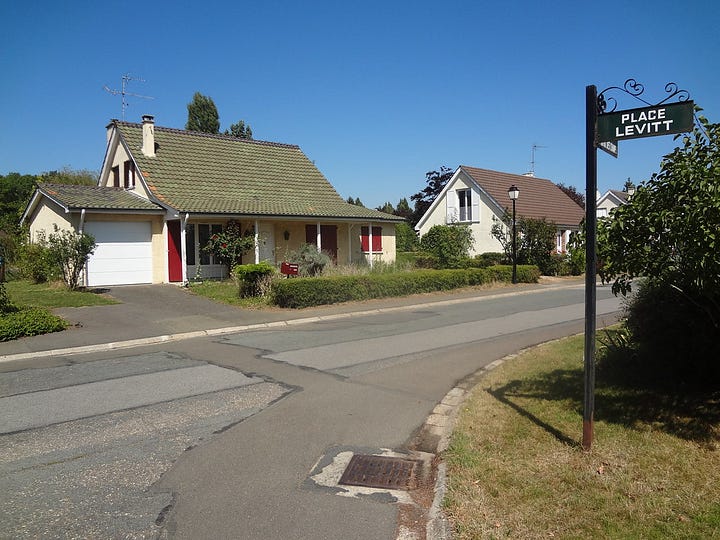
So some of the basic things like the balance between how many units of housing are this pavillons suburbs, and how many are HLM and higher density? Those balances are different, but not like, Europe lives on Mars, and we live on Venus. The balances are different, but so many of the aspects are similar, and people forget that.
Regional governments are another example. We have regional governance in the United States. It's not very strong, and it's not very good. When Paris decides to go regional, it does it with, you know, both feet forward, and all of a sudden it results in amazing new transportation infrastructure and all these things. We struggle to do it but the local, regional, national, some of these tensions, these also exist, and I think that that's a really important thing to think about.
Magda Maaoui: Absolutely. And I think my premise about why we need to talk about this convergence of models, and why it's interesting to think still, comparatively, was more of a premise, but it doesn't even start to answer things that we can answer with data points. You know I love data so, just to give people sort of a quick ID card of why they're so similar. Think about France, basically we have the same homeownership rate as in the US of at least 6 households out of 10 who own their primary residence, right? So, this is not Vienna. This is not the renters’ utopia that Francesca Mari speaks about so eloquently. We love homeownership. This is a model towards which we tend, and so the comparison between the two places makes sense. In the US, I think it's around the same. 6 households out of 10 approximately own their home.
Also, if you think about the constant, nostalgic reference about the little compact Neighborhood, with mixed uses and high-density apartments: France is super focused on single family housing. 55% of units in France are single-family housing. In the US, that's 67%, so it's a little bit more, but we're still very much up there. And there's actually an expression for that typology, that's called la France moche, “the ugly France,” which I think is super negative, and I never like to use it, because I think it's elitist to call it that way.
But la France moche basically represents the moment during Les Trente Glorieuses (the 30 years of postwar growth) the post war era Marshall Plan, marked by the obsession for America that France has. France wants to be America at that point, and there's this sort of big import of everything that's car-centric, from the supermarket to the strip mall to the single-family housing typology.
By the way, little anecdote, the first big box supermarket in France, that's inaugurated in a single-family-only district in the banlieue of Paris, is blessed by a priest, and welcomes one of our most famous writers at the time, Françoise Sagan, and she gives a speech about how we're becoming modern because we're looking more and more like America. That tells you a little bit about how heavily single-family focused a lot of the residential fabric is. Obviously, we don't have the problem that the US has, which is that this single-family typology is inscribed in the zoning, right? I think 75% of California is zoned for single families. I mean, it changed, but you understand that the roots are probably deeper, as Sonia Hirt, defines it. There’s definitely a zoning difference there, but the end result is still very similar. So something to add to the bucket of convergence that we think about.
Alex Schafran: Yes, my ex-wife's greatest fear was that I was going to make her move to a pavillon because she was convinced that she had married an American, and the next thing that was going to happen was that she would move to a pavillon. We're not married anymore, and I do live in a single-family house now. So maybe she was right.
It’s hard to overemphasize this. France both has one of the best high speed rail and train and transit networks in the world. I love it, but it also has a massive car culture. If you don't think France has a car culture, the major cars, the Peugeot and the Citroën, the big car companies, are huge parts of the economy and the politics. People love their cars, the French version of the AAA is super powerful and very influential. You also have big, fancy highways that get a lot of public money so that people can drive individual cars very fast.
In some ways, I think you managed to do in France and other parts of Europe – the Germans love cars too, is this kind of both and approach, where it doesn't feel like it's a zero sum game the way at times it is in the United States. The other thing that I find profound about the comparison is issues I you raised earlier, around immigration or race. I'll put a link in the written version of this, to some of my work with Yohann Le Moigne and others in France on how France has a multiracial democracy and a multiracial society, and the US have things in common. This, for me, is where a lot of the best American ideas are traveling from west to east, and that's something Yohann, speaking of awesome French scholars who've spent their time in California, shout out also to Frédérick Douzet, who was an important influence on me. I think one of the reasons why the comparison is useful is that the housing policy ideas that we're about to dig into occur in a society that looks more and more like the United States compared to maybe other places in Europe, or more homogenous societies.
Magda Maaoui: Absolutely. I also want to add a few caveats to that convergence. When I talked earlier about the fact that there's more and more involvement of the private sector, it is still super codified. Since 2008, it has been codified in ways that we have more and more private developers who are involved in building and providing affordable housing, if not social housing. They're not maintaining and managing it, which is an important part of the success of the model. 52% of new affordable housing units in France are produced through private development. That's huge. In America, just to give you a sense of comparison, it's one out of 1,000 developers who undertake affordable housing efforts. So we're not at the same level, right? Another thing that's important is, and I think we're going to get to talk more and more about this—I'm really getting into a long thread of thinking about construction costs—but it costs less to build housing in France, I think that's a big part of the equation too. That's a feature of our housing system where, to give you a sense of things, an average unit size is about 66 square meters.
Alex Schafran: Everybody get in with meters.
Magda Maaoui: I’ve been here a decade and I still just cannot think in other systems.
Alex Schafran: A meter is a little more than a yard.
Magda Maaoui: Well, for a 66 square meter unit, the cost ranges between 140,000 and 200,000 euros per unit. I'm not even going to start listing and shaming the cost per unit in places like Massachusetts or California. That gives you a sense of the big variations in metrics to keep in mind whenever we talk about, “Oh, let's import a French model of doing this or that.” We're aware that these metrics are influencing a big part of our outcomes. And then obviously, ownership of land.t's a big conversation right now in the US: what do we do with public land? What is public about public land, especially federal public land? I'm not even going to open that can of worms. But in France, it's a huge part of why we're succeeding in producing housing and providing housing. It's because we have these huge interregional, interdepartmental, etc.institutions that bank a lot of land and allow for projects to start from scratch without the hurdles that American projects can sometimes be faced with, and that's a third important metric to keep in mind as we go forward in our conversation.
Alex Schafran: Okay, so if this was a fancy podcast, there would be like, some sort of music right now, or a jingle where we'd be like, now is the segment of the show where we get into why France is better at building housing than America. So you just mentioned a few things, like land banking, which are not on your list of four. Let's start with your list of four, and then we'll get into more lists, because I love a listicle.
So give us your four lessons that American housing policy can learn from France and then we'll just keep adding to the list until we're done.
Magda Maaoui: I think we have to preface that by saying that this stems from a conversation we have a few months ago around: what can France teach California? And I think it's perfect, because California can be a snapshot of the rest of the country, even with more extremes in terms of how the market is faring and the challenges that are faced by the state, and also the current wave of reform that's happening on the ground.
The four strategies, because I love to give a roadmap, are as follows. I want to talk about national fair share mandates. I think they're important in explaining why France is doing things well. The second one has to do with small but mighty projects that are about infill densification and small-size unit projects and rehabilitation, adaptive reuse, things like that. They're more interstitial than master plans, because that's also a big part of the equation. The third strategy is more related to the ways we finance affordable housing, and that's where I talk about the big interdepartmental and inter regional agencies that allow to give resources, as in capital, but also land and infrastructure, to support the start of housing projects. The fourth one is really about public private partnerships. I really underscore the French style of doing 3Ps.
So let's start with the national fair share mandates. A few important things to keep in mind. We started a program in 2000, and we passed a law that's called the Loi Solidarité et Renouvellement Urbain. We will just call it SRU for now.
Alex Schafran: France does like a good acronym. Another thing we have in common.
Magda Maaoui: I think that's because we're planners and housers. So the SRU that's voted in 2000 imposes a minimum 25% social housing on a select large group of municipalities. The two main outcomes 20 years later are 1 million housing units that were built. We’re still short by 1 million to reach the goals that had been set by the founding mothers and fathers of the law back in 2000, but we're really on our way to producing a lot of it. And more than just a numeric evaluation 20 years later, the law was really more about territorial rebalancing. It was about how we can make social housing supply, not something that's about the concentration of poverty. I hate to use the word burden, but it’s sort of that, burdening certain territories that are already doing their fair share of social housing provision and not coming after the Palos Verdes and Beverly Hills of France, which we'll talk about in a second. So that was really a law that defined fair share mandates as the key signature of how we do social housing in France. That made France the country in Europe with the largest social housing sector in absolute terms. It’s roughly 4.5 millions units today. And it ranks it at a better level than its neighbors. I'm not going to mention the UK, because the UK is not even, you know, doing really well on that front, but it’s doing better than Scandinavia, Germany, etc. Really, France is doing well and is high up when we think about that ranking.
Alex Schafran: So for California listeners, I think you can think of the SRU a little bit like a hybrid between inclusionary zoning and the RHNA allocations, the regional housing needs assessment, right? But it is mandated from the higher form of government to local jurisdictions to be able to produce their fair share. And you know what Magda was talking about is that there were very particular politics, especially in the suburbs of Paris, between the places that had built a lot of social housing in the post war era and those that had not allowed it. Again, similar issues of segregation. There were big debates around segregation in France. Again, another French debate that was very much influenced by Americans. Conversations about ghettoization. This is where conversations about race, which are very difficult to have in France, came in. And so that's the background of the SRU.
Unlike RHNA in California, it actually produced a lot of units. I think some of the reasons why the SRU has worked are some of the other lessons that you're going to bring in there around housing finance, adaptive use, or am I wrong? Why is it that the SRU has worked?
Magda Maaoui: I think that it's faced with the same challenge that any housing policy, no matter its ambition, is faced with in the US in the sense that it's going to be voted on or decided at one level of governance, butthen implementation is the issue. As a reminder, France has inherited, since the 1789 revolution, a patchwork of 36,000 municipalities. It is hugely fragmented. And think about implementation that makes a law that is voted nationally in 2000, something that has to be, at the end of the day, implemented and carried by local levels of government. It's not just something that America has struggled with. France also struggles with the fact that everything that has to do with building permits, with prerogatives over housing construction, is really anchored and decided at the local level.
So that led to, originally, especially in the first 15 years of the law being passed, a highly unequal yield of housing provision when it comes to social housing, and it was not connected to unequal means or budgets. A lot of it was connected to political will. A lot of my research shows that there's a correlation between people's political affiliation of municipalities that are lagging behind and the fact that they're not sort of delivering on their promises, and the quotas that they're required to provide. It's about political affiliation. Over time, 70% of “outlaw municipalities”, who are non compliant, are typically from the right or the extreme right, or have had that type of political affiliation for over the 21st years of the law being in place.
There's also a connection with the tax base. It's typically around, I want to say a 20% higher tax base, on average, for places that don't want to comply with the law. And then there are other metrics that are really important, like age: places with older dwellers where there's probably more of a pushback against social housing and what it represents in people's minds. Sociologist Loïc Wacquantlikes to call that the social housing stigma.
Alex Schafran: But again, despite all of this, it's still been successful.
Magda Maaoui: It has been successful, and like I said, numerically, it's produced a million housing units that we were hoping for. It has allowed us to start rebalancing social housing provision. Even though there are these local elected officials who are sometimes running on no political agenda beside the fact that they're going to oppose the SRU. If the French Riviera, for many municipalities that are not excited about social housing, that is what elections are about. Municipal elections are about social housing and refusing to build it.
Despite this patchwork and pushback in some places, while others are really carrying the heavy load, I do think of the SRU as an equalizer in the efforts being carried out. That has to do with the involvement of so many levels of governance, more than the fines you have to pay. If you don’t comply, you have to pay a fine, which is not that much of your budget and doesn't really hurt your services that much, because a big difference between the US and the French services that are offered by municipalities is that we offer less of them at the municipal level. A lot is actually provided for by the state. So it's not really that big when you count it. Most recent numbers were around 203 million euros. What are you going to do with that? It's not necessarily outstandingly huge. But at the same time, you have other tools that have been deployed, such as the state coming in and taking away your permitting privileges and putting the prefect, representing the state level, as sheriff in town, trying to push you to build more.
There's also not just the politics of sticks and mandates, and punishing people. For the past few years, there has been a policy of trying to support and accompany, on a technical level, municipalities that were truly struggling with finding enough housing. So it comes to land use studies. Technicians are sent by the state, the region, and the department, to support those municipalities that are genuinely not finding innovative ways to reach the quotas. And so there's all these different levels of what we call the mille-feuille–we love a pastry metaphor in France.
Alex Schafran: Mille-feuille is a 1,000-layer pastry.
Magda Maaoui: Yes, and a metaphor for the multiple levels of government that all taken together help, I want to say, minimize the effect of local will, and trying to answer to your small electorate group who might not be as warm as you want them to be towards social housing.
Alex Schafran: The higher state in France is a little more willing to use the stick than we have been in California. There's constant threats to clawing back funding that have been really hard to implement. A lot of the focus has been on streamlining, or by-right, or basically where the state essentially removes a portion of the local jurisdictions’ power to say no. But what I think (and I'm excited to get into your other examples, because I feel like these other examples help build up the system of SRU), there's just a lot more state capacity, whether it's for public private partnerships or for housing finance. I'm convinced that we have probably just as many jurisdictions that are so overtly anti-housing or anti-affordable housing as you do, but the difference is that our jurisdictions that actually want to build housing, don't have the capacity, and the state of California doesn't have the capacity to really help them do that, and so it doesn't happen.
To me that’s one of the big differences and I think we’ll get into that when we get into other examples. So infill densification and adaptive reuse. It makes me think of another shout out to Anastasia Touati, an old colleague who used to write about the importance of “soft densification,” which was the small-scale stuff, as opposed to just the big towers and the kind that she called “hard densification. So what is it about the kind of infill densification that you think France has gotten right that we in California can learn from?
Magda Maaoui: That's such a good transition to this soft densification that I think requires us to zoom in on Paris for a moment. I don't like to only zoom in on Paris because I think Lyon, Marseilles, Bordeaux, Rennes and many other cities are doing fantastically on that front. But I do think that Paris has established a model that also made it into the success story that it is today. The Mayor's office was faced with a huge problem, and not just the Mayor's office, but all the representatives of the Greater Paris metro region. Nationally, there’s 2 million families waiting for social housing. Out of these two million, more than 730,000 just in the Greater Paris metro region, are on a waitlist for a social housing unit. So those waiting lists are also what makes people pressured to be innovative and strategic about adaptive reuse, infill densification, etc.
Alex Schafran: I wish it created that pressure here we have, you know, I'm sure the numbers of people waiting and needing are as high or higher.
Magda Maaoui: No, for sure. And so the way they did things was that Anne Hidalgo became Mayor in 2014 and she is not doing that job by herself. She has a Council (Conseil de Paris) that oftentimes is a tough one to handle, because she has to have consensus. It's all kinds of political representations having to approve her initiatives. But she also has a lot of deputy mayors, and planning agency representatives. I used to work at the planning agency of Paris, so I know a lot about that. And her Deputy Mayor for Housing, Ian Brossat, pitches this strategy of everything we have to do housing wise, going beyond this simple apparent challenge of “The city's built up, there's no more space for new construction, and we cannot do anything.”
So he starts pitching first, strategic ways of either upzoning or increasing the density over existing structures. Turning former parkings and offices and all kinds of buildings that had nothing to do with residential uses into something that could become housing units. And his big battle was also rebalancing within Paris. So Paris has historically been defined by an East-West separation, where the western side of Paris is much wealthier, whereas the eastern side is more popular–going back to a stark separation between social classes that really gets emphasized during Haussmannization in the 19th century.
Paris basically starts digging into the fact that it has zero big parcels to build on, and instead, a lot of infrastructure that could be welcoming new units. In addition to that, Paris has an aggressive pro-housing strategy with a small agency within the city of Paris that has the capital to buy back units, to turn them into social housing and affordable housing. Social housing in Paris increased from 13% in 2000 to 25.5% in 2024 and the goal that they want is 30% by 2030. With a little note, which is that by 2035 they want to reach 40% of affordable housing, not just social housing. These strategies are part of something that is not just a tiny infill strategy of whenever we find something to upzone, we'll go for it, and we have headhunters walking the streets of Paris and finding those spots. It has become even more so institutionalized by the mayor, because she knew she was going to leave office. This year is a very important year for Paris, because we are having mayoral elections in 2026 and right now, it's a big movement around who's going to be the next Anne Hidalgo. Nobody really knows who that's going to be, but Hidalgo wanted her legacy of being a green mayor for the bike lanes and the trees and Olympics and all that stuff that everybody knows her for, to also extend to a legacy of big pro-social and -affordable housing, by inscribing that into a zoning reform that covered the entire city, through a pioneer land use plan called the PLU Bioclimatique. That was voted in December 2024, and makes this strategy of finding tiny spots and turning them into social or affordable housing, especially in parts of Paris that are much wealthier than the rest of the city, something that becomes really codified and allowed by regulations.
Alex Schafran: I can't emphasize enough, if you spend time in Paris or in other big French cities, the amount of relatively small scale infill, affordable housing, social housing, that you will see. The office conversions, adaptive use is I feel like maybe just in the water in Europe. European cities have been doing adaptive reuse for 1000 years, it just sort of makes sense. But it's also, I think, not stopped you from doing big projects, like, if you go to the Batignolles, a huge project in Western Paris in the 17th on the edge of a very bourgeois area, but actually on a bunch of old rail yards, and just sort of figuring out how to do large scale.
Bordeaux, where I used to live, had three mega projects. I lived right on the edge of a huge, one square mile project in the Bassins-à-Flot area, that it's just something that we, again, can't do, and I've written about it, I feel like we've made a little bit more progress on some of the small-scale in California, but we really lag behind on our ability to do large-scale projects, which I think has to do mostly with state capacity. I think you've learned in France how to do large-scale projects over the years, whether it's a La Défense-style project that is mostly commercial, or whether it's large scale housing, and you learn from your mistakes, right? The ways you did some of it after the war, created situations that were unfortunate, and rather than abandon the state capacity, it’s like, no, the state has to learn, we have to get better, and we're going to get better, and we're doubling down, which brings us to the next two lessons you’re discussing today.
Let's talk about financing affordable housing. What are the things from the French system that you think are really important for us to understand?
Magda Maaoui: To us, the balance lies in that it's not just a question of steady and important social housing financing by century-old institutions and developers. It really has to do also with a deep reliance on harnessing publicly-owned land that really stems from a tradition of post war grands ensembles (large public housing projects) exactly like you described, with the good and the bad. There's still some grands ensembles that today have been hyper renovated, I’m thinking of the work of architect duo Lacaton et Vassal the Pritzker Prize for that. There is a new chapter for these grands ensembles, but the majority of them were a disaster, just like the projects in the United States and the fate of public housing pre-dismantling.
Here’s a recap of the way this works. France's 4.5 million social housing units have been historically financed by the same traditional channels. For instance, you have government subsidies, reduced taxes on construction, low-interest loans from the biggest funding institution--if you want to remember one acronym it’s CDC. It's not your CDC. It's our CDC. It means, Caisse des Dépôts et Consignations. It's really our public investment bank in charge of housing financing, a key actor in doing everything. For management, key players are this long list of local housing authorities with portfolios of super varying sizes, some of them really tiny. And I want to underscore that part, because that can teach us something about the American landscape, thinking again about translating best practices.
I want to underscore one institution that I can describe to help show what it means for us to finance affordable housing by really bringing in hand in hand the right capital and the right land resources. They're called EPFs, again an acronym, I'm sorry. This one refers to Établissements publics fonciers (public land agencies) The one that is in charge of the Île-de-France region, which is the larger region where Paris, the capital city, sits, has an annual budget of 540 million euros, and it provides technical assistance to reach goals that are set by regional plans. By technical assistance, I'm talking about supporting all kinds of housing developers, assisting them with capital advice, but also providing land at the basic cost of an operation. So it's acquisition costs plus carrying costs, minus rental income, and that really makes a big difference.
The EPF has, for instance, between 2013 and 2018, provided 50% increased land transfers for housing, and that has generated and spurred all kinds of projects of varying sizes. And that really plays a huge role in how we are able to just kick start projects. And so I know we were talking about infill and tiny scales for a while, but really, what it allows us to do is also to continue doing master plans really well.
Another acronym–this is becoming French lesson acronyms with Professor Maaoui– but the ZACs (or Zones d’Aménagement Concerté), which are the perimeters of big master-planned projects, are possible thanks to institutions like the EPF that facilitate bringing together capital, land resources that have been sitting there for a long time, and also the technical assistance that's required to carry such large projects.
That's not just for new construction, these institutions also allow, when they have specific amenities or infrastructures near existing housing projects, to also support renovation initiatives in the face of climate adaptation. A lot of grands ensembles, or public housing projects, have to be rethought from the perspective of renovating and rehabbing their internal structure, but also thinking of them more at a master-plan or neighborhood-planning level.
I remember a newsletter that you sent out, Alex, where you were underscoring how thinking at that scale could allow California to be better at planning. It's not just about housing. It's also about how we have to rethink planning processes at this scale, with infrastructure that's sitting there, that's old, that's decaying, while nobody's doing anything with it. That's a little bit of what these EPF agencies are allowing us to do. Connect housing to all kinds of neighborhood amenities, renovate the whole thing, and really allow for it to become the starting point of those good neighborhood outcomes I was talking about earlier from a health, quality of life, educational perspective, and so on.
Alex Schafran: As a way of translating it to California, the closest thing we have is our old redevelopment system, which was both a mixture of public power, an ability to draw lines around certain lands and say we're going to do some change in this space, and the financing mechanisms to help make that happen.
Okay finally. The PPP à la française. I'm really curious how you're going to define this. This is the public private partnership done French style. I've got one thing that I love about French style public private partnerships but what is it that we can learn in California from them, especially for housing?
Magda Maaoui: When I talk about the 3Ps à la française, I do mean that there's a coming together of the public sector and the private sector, but that the private sector is sort of considered as locked, or really minimized in its role and capacity in terms of decision making. So they're allowed to pay for the units, to build them, and to benefit from abatements, through that framework. But at the same time, they're not really allowed to say anything about the look of the project, the siting of all kinds of typologies of units when it’s for mixed-income projects, and they're certainly not going to be able to manage the moving-in of new residents, the selection process, any of that. They just deliver, and that has been a huge element of the success of France not falling into a recession in terms of construction of social housing units after 2008, because they were allowed to channel that private capital, and sustain a number of housing units being produced that was sufficient enough to replace what the public sector had been doing so far.
Alex Schafran: It's an amazing system. The French social housing system is not built entirely by the public sector. It is built in huge part by private sector actors. But everybody kind of agrees that this is our lane, this is the thing that we do, and we don't do this thing. And there's an agreement, there's a collaboration. As opposed to the United States, it feels like it's a constant political battle about which sector is meant to do what. And people have this imagination that if it's going to be public housing, then the public is going to do everything, and if it's private housing, then the private does everything. And it's just also not really how things go. One of the things I love about France isn't just the design of the public-private partnership. It's an implicit recognition that everything that is large and important in society is a public-private partnership.
You have the public sector and the private sector and the kind of community sector, all these people are involved in everything and always. And it's just like, can we come to an agreement that gets us the thing. The ideological battles about sectors we have just don't seem to be as apparent in France. There's just an agreement of, “How do we get this done?”
This is the same thing that works in Vienna, where social housing is built largely by private corporations who compete with each other. Again, the private companies do certain things. The limited profit companies do other things. The state does other things. Or Singapore. When I try to explain Singapore public housing to people, my favorite thing to do is to send them the list of the Housing Development Bank annual awards where they're recognizing all of their partners, and it's this construction company and that architecture firm, all of which are private for-profit companies, but who have a symbiotic relationship with the Singaporean state, where everybody is getting together and working, one group does this thing, the other group does that thing, and the end result is housing. And that is, I think, our failure here in the United States.
Magda Maaoui: I agree, and that's actually something that I give as an exercise to my students. I ask them to dissect who were the stakeholders involved in the construction of projects around the world, and they're so taken aback when they're talking about public projects, and they see that there's a lot of private actors also involved in the process, and it still is a public project at the end of the day.
Remember when I was telling you that everything stems from crises and, to be a little hopeful, that is also the moment where we shift to this public private partnership model for the provision of social housing in France. Again, acronyms for everyone. But I'm sure the people who listen to this podcast love it.
Alex Schafran: We love acronyms.
Magda Maaoui: So the VEFA (Vente en l’État Futur d’Achèvement, or off-plan sale), which basically means that the transaction over the future units happens before they got built. And so you buy a stock of agreed upon units, and they've already perhaps been bought by private households. We can talk about this later for home ownership purposes.
The fact is that in 2008 there's a moment of recession and the public sector is having a hard time, but it's private developers themselves who are having a hard time selling anything, so it's a mutual agreement, called the operation of the 30,000 VEFA. That’s 30,000 units that are agreed upon as this first big public private partnership between the state and a few developers. We work with monopolies in France, and we have two huge developers who are basically big partners of the state: Bouygues, and Vinci. There are other smaller developers, but I won't mention them, and they basically partner together to create these 30,000 units that get sold to social housing developers. That's done in such a seamless way, and helps everybody out so much, that it becomes the model. Again, food for thought, as we're faced with the biggest challenge of all right now, and everybody seems to be willing to have a conversation about public developers in this country.
Alex Schafran: Well I hope we get to have you back on the show at some point to talk about the restructuring of the housing system, and in particular the affordable housing system, I just can't emphasize enough a couple of points that you made. One is, I think you mentioned earlier, the idea that affordable housing providers can buy units. One of the most important things about the French system is that the buildings are often condos or you have separate ownership of each of the units.
And so often affordable housing works that just individual units may be owned by different affordable housing providers. That is one of the most important things if you're an affordable housing developer listening to this show. I cannot emphasize enough. We need to move away from systems in which you're building buildings and operating entire buildings, and moving to systems, where you're able to buy units on the marketplace, in different parts of the city, and be that kind of interlocutor between people who want to live in those units and folks there. That's super important.
Number two is what you talked about. This act of pre-selling, right? You lock in permanent finance in France by selling all of the units beforehand. Nothing gets built in France unless almost all the units are sold. Loi Pinel is my favorite example of that, because it provides a pathway for middle income folks to be investors in individual units that have to be rented out.
I maybe want to do a whole show on Loi Pinel, because I think it's super innovative. It creates both middle-income investment opportunities, and rental units, because they have to be rented for a certain period of time, and it creates that financial certainty for the developer. They know they can break ground, knowing that they can sell the units and the cost of everything is agreed on beforehand. It's solving the financing problem, it's solving the rental housing problem, and it's solving middle-income investment and wealth-building for regular folks in France, which is super important.
I think one of the things that France is just better at doing is kind of connecting the dots, like a lot of the different pieces of the system fit together. It's more of a systemic approach than everybody doing their own thing, this ridiculous story in America. There's a level of thoughtfulness that connects things in the back end in France, and that makes it feel like you're maybe part of a system, unlike the United States where it just feels like you're part of this kind of constant ideological war and everybody stays in their lane and tries to do their own thing by themselves, and we end up with something that is not a system. It's just a kind of chaos in which people are just under housed and under happy in the housing that they have.
Magda Maaoui: I love the fact that you're commenting on connecting the dots and weaving together parts of an ecosystem that then can be resilient. I think It is truly part of the French DNA, housing wise. And I really do think that we emphasize today a lot of examples of places that people heard of and that strike people as thriving places. But I want to underscore that this is happening also in disinvested suburban banlieues municipalities led by mayors who face so many budget constraints and limitations, and they're still doing that fantastic work of standing up to developers, transacting with them, working with them, partnering with them, and doing that work of connecting the dots, even when the regimes in which they're operating are harder to operate in. Just one element of conclusion: we talked a lot about convergence, but I want to underscore that the US and France are really starting from widely varying baselines. Housing market conditions and needs, current laws, institutional capacity, policies, are really reflecting unique histories, legal challenges, political environments. I'm not trying to say otherwise.
At the same time, we are at a moment of huge, huge momentum for reform and good decision making, despite this feeling of crisis that we're faced with. There's unprecedented public attention around housing production and affordability, and just the fact that it's being slashed from all parts. I really think that there's this momentum that we have to take advantage of.
And to recap the four strategies that I wanted to talk about today with you, here are my quick takeaways. We have to make housing goals mandatory. It cannot just be free will. Second, we have to think about multi-level enforcement and financing. I know federal right now is not really an option, but still all the other levels and sectors can chip in and do the work. Third, we really have to think about diverse coalitions. And that's my time, not working in France, but working in California, actually, that really leads me to say that. Diverse coalitions can back the housing industry. You're one of the people, Alex, who talks about the housing industry. And I want us to think at that scale too. Fourth, prioritizing territorial rebalancing, just trying to get a dent into exclusionary enclaves, that is the challenge of our next 20, 30, 40, years. And lastly, we have to continue riding the current reform wave. I know right now we're feeling a little pessimistic, but the reformers are there. The coalitions are built, and people have the toolboxes to just continue riding that wave, if I may say so, as hard as they can.
Alex Schafran: Well, Magda, it's a pleasure to have you. Thank you so much for your readership and your friendship and colleagueship over the years. I'm super excited that Harvard and you have started this relationship and that we have you in this country for hopefully quite some time, and I look forward to more.
And thank you to all my listeners for listening. Pay more attention to France, not just because Victor Wembanyama is coming for the throne, but because there's just a lot of really interesting things that you can learn.
Thank you, Magda.
Magda Maaoui: Thanks so much, Alex.
Apur, the Paris planning agency, was created in 1967 by the Paris City Council. Apur’s mission is to document, analyse and develop forward looking strategies which address the urban and societal evolution of Paris and Greater Paris (Métropole du Grand Paris).
It is:
A tool at the service of urban development public policy makers and development on Parisian and metropolitan scales;
A pathfinder in setting up the Métropole du Grand Paris while taking into consideration its characteristics and competence as defined in the text of the Maptam Law for the modernisation of territorial public action and the assertiveness of metropolises;
A platform for exchanging information, sharing construction and distribution with all the key players in Paris and the Métropole du Grand Paris, technical syndicates, public establishments, municipalities and its citizens.









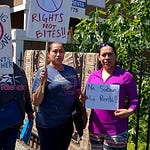



Share this post